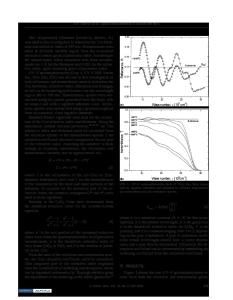Residual stress and microstructural evolution in thin film materials for a micro solid oxide fuel cell (SOFC).
- PDF / 91,038 Bytes
- 6 Pages / 612 x 792 pts (letter) Page_size
- 25 Downloads / 321 Views
U8.19.1
Residual stress and microstructural evolution in thin film materials for a micro solid oxide fuel cell (SOFC). David Quinn1, S. Mark Spearing2, and Brian L. Wardle2 1 Department of Mechanical Engineering and 2Department of Aeronautics and Astronautics, Massachusetts Institute of Technology, Cambridge, MA 02139, U.S.A. ABSTRACT The stability of multilayered membrane structures is a major challenge in the development of microfabricated solid oxide fuel cells (SOFC). The work presented here explores residual stress in sputter-deposited yttria stabilized zirconia (YSZ) thin films (5nm – 1000nm thickness) as a function of deposition pressure and substrate temperature. The results indicate variations in intrinsic stress from ~0.5GPa compressive to mildly tensile (~50 MPa). Microstructure is characterized by x-ray diffraction (XRD). The evolution of intrinsic stress with temperature is investigated by thermally cycling YSZ films deposited on silicon wafers. Observed changes of 100s of MPa in the intrinsic stress component of the film serve as indicators of possible changes in microstructure. Such changes in microstructure are subsequently characterized using x-ray diffraction of as-deposited and annealed films. Correlations with relevant mechanisms and models of residual stress evolution are discussed. Finally, use of such residual stress data in the fabrication and design of mechanically stable multilayered membranes for micro SOFC devices is discussed. INTRODUCTION Microfabricated solid oxide fuel cells are currently being investigated for portable power applications requiring high energy densities (1, 2). Proposed devices utilize multilayered membranes made by bulk micromachining techniques whereby a fuel cell stack consisting of anode, electrolyte and cathode materials, together with supporting structural layers, are deposited onto a silicon substrate. The membranes are then released using anisotropic etching in KOH. Such a strategy is attractive as it reduces the thicknesses of the stack materials, especially the electrolyte material, which reduces the ohmic losses and improves the overall electrochemical performance compared to traditional devices. This desire for thinner structures combined with the high operation temperatures of such devices (~600 – 1000 °C) means that the thermomechanical stability of such membranes is a major consideration as the membranes must be designed against failure during both the fabrication process and device operation (2). A critical input to the structural analysis and design of these multilayered membranes is the residual stress state. The current work has been performed to characterize the residual stress and microstructure of the electrolyte layer of the fuel cell stack, with the aim of providing improved process control and input for the design process. The material examined in the present work is sputter-deposited yttria stabilized zirconia (YSZ). EXPERIMENTAL DETAILS YSZ films were deposited via reactive RF magnetron sputtering using a 2-inch target with a molar composit
Data Loading...











